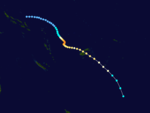1992–93 South Pacific cyclone season
| 1992–93 South Pacific cyclone season |

Season summary map
|
| Seasonal boundaries |
| First system formed |
December 3, 1992 |
| Last system dissipated |
April 6, 1993 |
| Strongest storm |
|
| Name |
Prema |
| • Maximum winds |
185 km/h (115 mph)
(10-minute sustained) |
| • Lowest pressure |
940 hPa (mbar) |
|
| Seasonal statistics |
| Total depressions |
12 |
| Tropical cyclones |
10 |
| Severe tropical cyclones |
6 |
| Total fatalities |
None reported |
| Total damage |
$18.5 million (1993 USD) |
| Related articles |
|
|
South Pacific tropical cyclone seasons
1990–91, 1991–92, 1992–93, 1993–94, 1994–95
|
| Category 4 severe tropical cyclone (Australian scale) |
| Category 3 tropical cyclone (SSHWS) |
|
|
| Duration |
December 3 – December 14 |
| Peak intensity |
165 km/h (105 mph) (10-min) 940 hPa (mbar) |
| Category 3 severe tropical cyclone (Australian scale) |
| Category 4 tropical cyclone (SSHWS) |
|
|
| Duration |
December 23 – January 6 |
| Peak intensity |
150 km/h (90 mph) (10-min) 955 hPa (mbar) |
| Category 3 severe tropical cyclone (Australian scale) |
| Category 1 tropical cyclone (SSHWS) |
|
|
| Duration |
January 1 – January 5 |
| Peak intensity |
140 km/h (85 mph) (10-min) 960 hPa (mbar) |
| Category 3 severe tropical cyclone (Australian scale) |
| Category 2 tropical cyclone (SSHWS) |
|
|
| Duration |
January 30 – February 5 |
| Peak intensity |
120 km/h (75 mph) (10-min) 970 hPa (mbar) |
| Category 1 tropical cyclone (Australian scale) |
| Tropical storm (SSHWS) |
|
|
| Duration |
February 3 – February 9 |
| Peak intensity |
85 km/h (50 mph) (10-min) 987 hPa (mbar) |
| Category 2 tropical cyclone (Australian scale) |
| Category 1 tropical cyclone (SSHWS) |
|
|
| Duration |
February 9 – February 16 |
| Peak intensity |
110 km/h (70 mph) (10-min) 975 hPa (mbar) |
| Category 1 tropical cyclone (Australian scale) |
| Tropical storm (SSHWS) |
|
|
| Duration |
February 14 – February 20 |
| Peak intensity |
75 km/h (45 mph) (10-min) 990 hPa (mbar) |
| Category 3 severe tropical cyclone (Australian scale) |
| Category 3 tropical cyclone (SSHWS) |
|
|
| Duration |
February 27 – March 9 |
| Peak intensity |
155 km/h (100 mph) (10-min) 945 hPa (mbar) |
| Category 1 tropical cyclone (Australian scale) |
| Tropical storm (SSHWS) |
|
|
| Duration |
March 20 (Entered basin) – March 22 |
| Peak intensity |
75 km/h (45 mph) (10-min) 985 hPa (mbar) |
The 1992–93 South Pacific cyclone season was a near average tropical cyclone season with ten tropical cyclones occurring within the South Pacific to the east of 160°E. The season officially ran from November 1, 1992, to April 30, 1993, with the first disturbance of the season forming on December 3 and the last disturbance dissipating on April 6.
During the season, tropical cyclones were monitored by the Tropical Cyclone Warning Centers (TCWC) in Nadi, Fiji, and in Wellington, New Zealand. Whilst tropical cyclones that moved to the west of 160°E were monitored as a part of the Australian region by the Australian Bureau of Meteorology. Both the United States Joint Typhoon Warning Center (JTWC) and the Naval Western Oceanography Center (NWOC) issued unofficial warnings within the southern Pacific. The JTWC issued warnings between 160°E and the International Date Line whilst the NWOC issued warnings for tropical cyclones forming between the International Date Line and the coasts of the Americas. Both the JTWC and the NWOC designated tropical cyclones with a number and a P suffix with numbers assigned in order to tropical cyclones developing within the whole of the Southern Hemisphere. TCWC Nadi and TCWC Wellington both use the Australian Tropical Cyclone Intensity Scale, and measure windspeeds over a period of ten minutes, while the JTWC and the NWOC measured sustained winds over a period of one minute and use the Saffir–Simpson Hurricane Scale.
On July 1, 1992, the New Zealand Meteorological Service (TCWC Wellington) was broken up and became the Meteorological Service of New Zealand and the National Institute of Water and Atmospheric Research.
...
Wikipedia
















